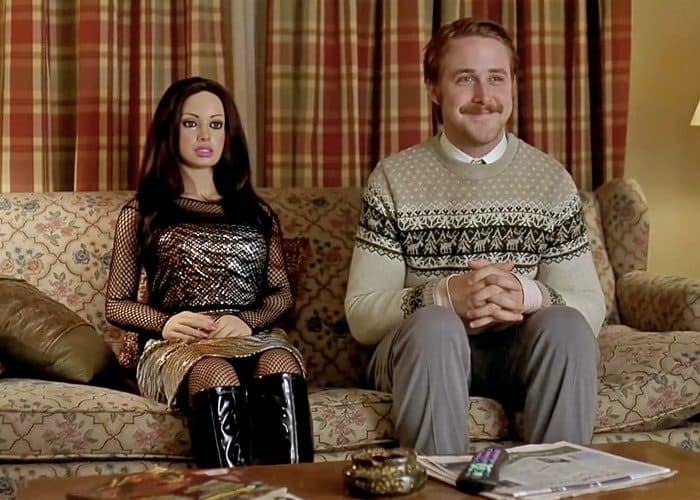Dagmar: Sometimes I get so lonely I forget what day it is and how to spell my name.
Novice film director, Craig Gillespie, would like you to meet Lars Lindstrom (Ryan Gosling). Lars lives in a small, northern American town where everyone knows each other. Lars works in a dreary office where the most excitement revolves around his cubicle-mate’s missing action figures. He lives next door to his brother and pregnant sister-in-law (Paul Schneider and Emily Mortimer) in what is not so much a place of his own as it is his brother’s garage. He doesn’t like to be touched; in fact, he considers the often-casual act of embracing to be painful, like the feeling your feet get when they’re thawing after a long time in the freezing cold. He lives a solitary life in the safety of his dark, underdone home, watching curiously from his window. If you were to ask him if he was lonely or if he were OK, he would say he was fine and finish the conversation before you could probe any further. Lars is that guy that everyone always knew had problems but no one was willing to put aside their own long enough to help. In “Lars and the Real Girl”, Gillespie is more than happy to introduce you to Lars Lindstrom, if only so someone can look at him instead of away from him and see this beautiful human being that has been ignored for far too long.
There is one person in Lars’s life that doesn’t look away. Her name is Bianca. Bianca allows Lars to be himself and loves him for who he is. The only problem with Bianca is that she isn’t real. She arrived at Lars’s door one day in a large wooden box after he ordered her online six weeks earlier. She is made of plastic, has real hair and is anatomically correct. Even though she is designed for sex play, Lars brings her to life for a safe return of love. It is funny at first but it quickly becomes horribly awkward. Suddenly, those that were thought to be closest to Lars realize that they allowed for this to happen by not stepping in earlier. Upon covert psychological analysis (by Patricia Clarkson in a stoic, frank performance that is brutally honest while always sensitive), Lars is diagnosed as having a delusion. Maybe he believes that if people see him with Bianca they will stop judging him for being so pathetically lonely. Maybe it’s as simple as he just wanted someone to talk to. No matter what the reason that led to this mental snap though, Bianca’s arrival is the best thing that could have happened to Lars and to everyone who knows him. Despite the minor inconvenience of her being inanimate, her relationship with Lars brings him back to life.
“Lars and the Real Girl” is bravely independent. Gillespie has taken Nancy Oliver’s script/psychological case study and ensured that we as viewers are never allowed to look away from Lars, no matter how uncomfortable we may be. That said, the film experience itself is certainly not an easy one. Lars is not a clumsy yet endearing kind of awkward. He is a man with real problems and rich history that is unveiled piece by piece throughout the film. Fortunately for the film and the audience, Lars is played by a young actor who is not afraid to explore the dark place Lars calls home (and I’m not talking about the dank garage where he sleeps). Gosling is sincere in his suffering, in his caring and in his instability. Both he and Gillespie never allow for Lars to drift into caricature or ridicule. The earnestness of Gosling’s performance, from his difficulty getting words out to his flinching body language, inspires genuine sympathy from the audience and saves the performance from being the farce it could have been in the hands of a lesser actor. It also elevates the film to a compelling study in humanity as the manner in which the townsfolk react to Lars and Bianca says novels about their decency and compassion or lack thereof.
“Lars and the Real Girl” is sure to repel some but is extremely cathartic if you allow for it to work its magic on you. Even “magic” is not the right word as there is nothing magical about this movie. Considering it’s about a relationship between a man and a blowup doll, it is shockingly real. Loneliness is real. Mental anguish is real. Bianca may not be real but the love Lars feels for her is and the experiences that led to this delusion are valid and should not be ignored. Perhaps it isn’t just that Lars needed someone to talk to or someone to have as a standing Saturday night date. Perhaps Lars created Bianca to show himself that he truly deserved love despite it never showing its face to him before. In doing so, maybe he would learn that he already had an abundance of it.
Review by Joseph Bélanger

